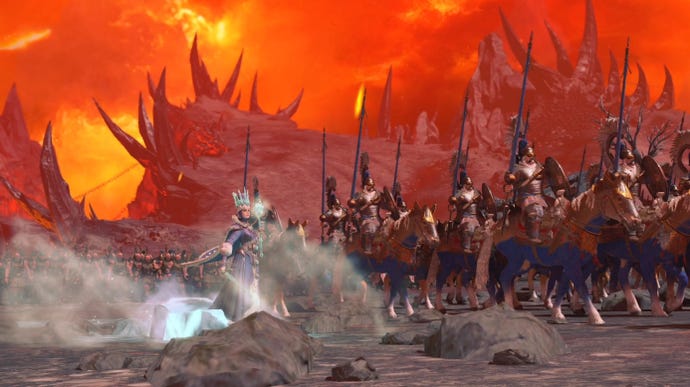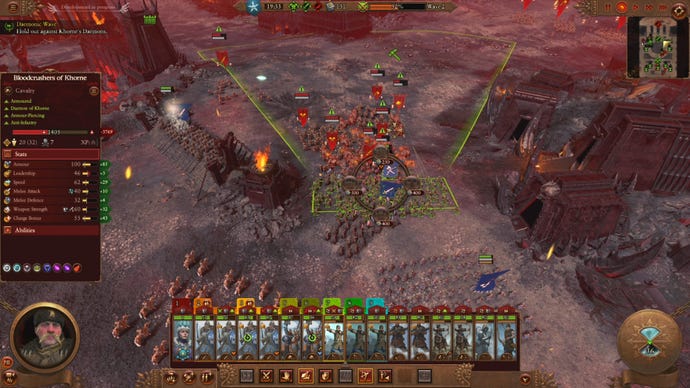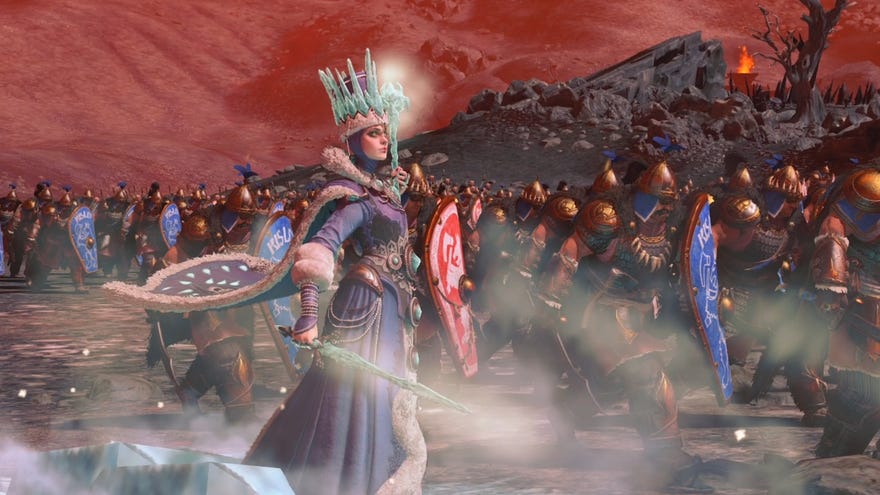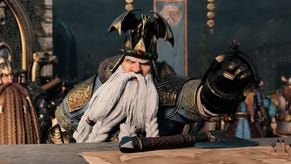Total War: Warhammer 3 brings tower defence, boss fights and lakes of sick to Total War; I like it very much.
A hell of a fight
Tower defence and Total War are not, you might think, two tastes that go particularly well together. You’d be surprised. Last month, I got to play one of the set piece battles from Total War: Warhammer 3, which saw an army of furious fantasy Slavs, battling to fortify a toehold in their invasion of hell. There were barricades built, hoards of devil dogs wiped out by AI-controlled, magic-spaffing turrets, a gigantic polar bear made out of moss and dirt. You know, normal, reasonable things. And it was bloody wonderful.
It was interesting, you know, seeing your reactions to last month's remaster of Total War: Rome, a game originally released during actual Roman times when centurions walked the earth. I learned there were more people than I thought, for whom the entire Total War experience peaked in those long ago days of the early 2000s. To these grognards (and I use the term with respect, even though it sounds like a medical term for dying pirates), the series’ main strength was always its commitment to realism: things started going downhill with the advent of faster battles in Shogun 2, and whenever it was that armies of men learned to transform into boats at will, rather than be forced to load into separate naval units.
I doubt it will be a surprise to such traditionalists, if I say that Total Warhammer 3 is not going to be the game for them. You know, even more than Total Hamwarmers 1 and 2 were not for them. Because this game, frankly, looks bonkers. And coming from me, that is both a considered and unambiguous statement of praise.
"This game, frankly, looks bonkers. And coming from me, that is both a considered and unambiguous statement of praise."
This series has always been an exercise in extravagance, after all, in line with Games Workshop’s typically maximalist take on fantasy. The number of factions introduced over five years, two games, and a relentless flood of DLC, has reached the point where few humans alive could conceivably have played a campaign as all of them. The variety of units, spells and special mechanics involved is dizzying, and such is the bulk of the Mortal Empires campaign - which stitches together the first two games in their entirety - that entire civilisations can remain semi-broken for years, submerged in a deep sea of other things to do.
But TWW3 will not simply be a third bucket of sausages, tipped onto this already-groaning wheelbarrow of meat. In the words of Lead Battle Designer Jim Whitstone, Creative Assembly want to “go out with a bang” on their fantasy extravaganza, pushing the man-who-turns-into-a-boat out in every aspect of the game.
And so we come to the bit of it I played, in which the forces of Kislev (who are a bit Russian, a bit Polish, and a whole lot extrapolated from a middling presence in the tabletop game), have broken through the barriers of reality itself in order to invade the realm of Chaos. Or rather, the realms of Chaos. Because hey, why have one hell when you could have four, right?
This realm belongs to Khorne, the god of pub car park fistfights, and consequently it is an eye-pummeling wasteland of flames and gore, strewn with brutal monoliths of red iron and vast, blood-chundering skulls. It’s so much richer and busier than any battlefield I’ve Total Warred on before, and I’m curious to see its sister locations in the realms of Tzeentch (bird-faced god of shitposting), Slaanesh (the artist formerly known as Captain Sex), and Nurgle (the master of bin juice). The realm of Nurgle, I force game designer James Martin to admit, has actual lakes of sick. It’s a far cry from Rome’s “tall grass” and “forest” terrain, eh?
Anyway. The brave lads and lasses of Kislev have invaded this place under the leadership of Queen Katarin, who’s like a metal version of Elsa off of Frozen, and who has a hotbar packed with extremely powerful ice spells. They are faced with the new “survival” battle type, in which their mission is to seize and hold three capture points. Each of these points provides a battlefield-wide buff for whoever holds it, is guarded by a swarm of daemons, and is placed successively deeper inside the stronghold of the blood god.
What’s more, the brave not-quite-Russians can’t just fight and move on. Once taken, each point must be held against a massive initial counterattack, coming from every direction at once, and then a permanent trickle of infernal bastards from the map’s edge. Oh, and then they have to fight a gigantic flying satan, aka the greater daemon Bloodthirster, in order to win the day.
As you can imagine, this is all way in excess of the level of opposition one would face in even the most pitched endgame battle of Total Warhammer 2. Even the counterattack at the first capture point made my mouth fall open a little bit, like the blokes at Helm’s Deep in Lord Of The Rings, when they see ten thousand of Christopher Lee’s beefiest boys wading towards them down a canyon.

Luckily, however, you’re not expected to manage all of this with the strong, but inconveniently finite, force of troops you start the battle with. At each capture point, you gain control of a portal through which reinforcements can be summoned, as well as a number of hardpoints where either towers or barricades can be constructed. As the third string to this bow, you can perform mid-battle upgrades to any of your individual units, beefing up their attack, armour or shield values, healing them, or giving them an encouraging team talk.
All of these activities have a cost in “supply”, a generic token resource earned through killing devils and maintaining control of capture points. The game is pretty generous with the amount it allots you, and yet at the same time, it’s never enough to make you feel like you’re doing more than clinging on by your fingertips against the horde.
Hard decisions must be made: do you spring for the big lad magic turrets to whittle down incoming swarms, or crank up the murder score on your shock cavalry in order to get the job done up close? Do you build unscalable walls, and usher cheap battallions of archers into the bloodzone to fire volleys over them? Or do you erect cheaper, lower barricades, and spend the leftover money on riflemen to line the parapets? If it makes it any easier to decide, I should mention that the riflemens’ guns are also axes.

Sober historical battle simulation, this is not. It’s a pitched, overwhelming, relentless brawl, which gives the exact sensation of budget-rinsing, too-much-to-take-in madness one expects to find at the back end of an incomprehensible summer blockbuster. And there, I suppose, is the one sticking point I found with this battle: it was genuinely too much for my mind to take in.
Balancing unit orders and hero ability micromanagement across a single front is taxing enough. Add in a management and construction metagame, however, as well as three big fights with 360-degree fronts happening simultaneously, and you’ve got a real headache brewing: it’s just too much cognitive load. I’m not bad at Total War, and can usually command a battle as it plays out in standard speed. But here, I spent probably eighty percent of my time in the viscous, muted confines of slow-mo mode, and the lion’s share of the remainder paused entirely. I felt a little sad having to de-immerse myself from such a gorgeously kinetic, violent environment, and at times it felt as if I was having to play an RTS as a turn-based game, just to keep track of it.

With all that said, however, these apocalyptic beastings will not be the norm in TWW3. Whitstone made it very clear that the survival battles will be exceptional, landmark events, placed at climactic points in the faction campaigns where they rightly belong. What I really like, too, is that they’ll be playable in isolation from the main menu, with players able to choose any combination of faction, chaos realm, and reinforcement rosters to play with.
For the first time, too, there will be co-op functionality - so if you and your best mate want to send the last alliance of orcs and rat men on a desperate assault on the Kingdom Of Sick, Total War: Warhammer 3 can make your dream come true. Indeed, when I asked Martin about this, he told me that up to four players could take on a survival battle together, “so one player could focus on defence, one on pushing forward, and so on.”
"If you and your best mate want to send the last alliance of orcs and rat men on a desperate assault on the Kingdom Of Sick, Total War: Warhammer 3 can make your dreams come true."
This preview event was, perhaps reasonably, focused entirely on showcasing the new battle mode. But there’s clear implications for the rest of the game here, too. Whitstone agreed that it would be reasonable for me to suppose, for example, that all the customisable towers and barricades featured seemed an obvious carryover from a complete reworking of sieges, which have always been the Total Warhammer series’ notable weak spot. Given it was also announced that minor settlement battlements, previously indistinguishable from field battles, were being reworked, a farewell to samey urban warfare seems to be on the cards.

There was also some talk about another new battle mode, ominously referred to only as “Domination”. I didn’t find out much more about Domination battles, other than the fact that they, like the survival battles I played, supported multiplayer participation. Fingers crossed, I’ll know more about that soon.
Did the survival mode battle feel over the top, even arcadey? Yes, one hundred percent. But crucially, it also felt exactly in line with everything that’s made me sink hundreds of hours into the Total Warhammer games up to this point. Not to put too fine a point on it, I’m coming to this party because I want to get totally smashed, and it doesn’t look like I’ll be disappointed.









